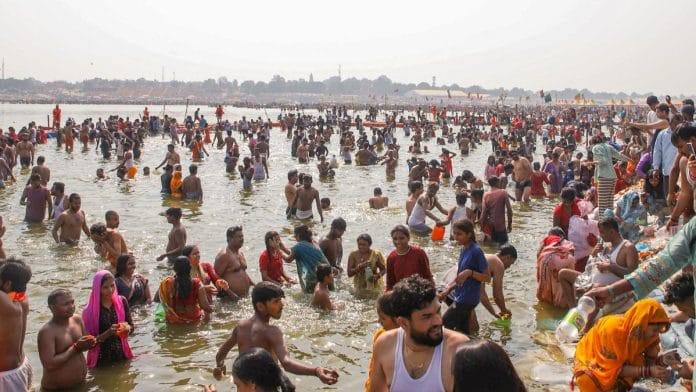In 1896, a British bacteriologist named Ernest Hankin stood on the banks of the Ganga, watching as locals filled clay pots with water. He hoped that the dreaded cholera outbreak would not occur under his watch. In his attempt to avert it, Hankin discovered something extraordinary: water drawn from the river seemed to kill the pathogen within hours. In wells where the Ganga’s water was not introduced, however, the bacteria flourished.
Intrigued, Hankin conducted experiments, filtering and heating the water to determine what made it so inhospitable to cholera. He hypothesised that an unseen biological agent was at work. The notion that the Ganga River could retain its self-purifying properties defied conventional wisdom. Even as evidence mounted, the idea was dismissed as anecdotal—a quirk of the river’s mythology rather than a function of science.
Hankin’s discovery would take another three decades to be recognised as the action of bacteriophages: viruses that prey exclusively on bacteria. It wasn’t until the 21st century that modern research tools finally confirmed what Hankin had suspected.
Several recent studies have mapped the prevalence of bacteriophages in the Ganga River, in water samples collected from Hardwar to Varanasi. These studies have found unusually high concentrations of phages targeting common pathogens of waterborne diseases. Some scientists have even isolated bacteriophages that neutralise deadly, antibiotic-resistant bacteria.
When phage therapy was first discovered, researchers were elated that the Ganga was an untapped reservoir.
But bacteriophages exist only because its prey, the bacteria, is found in abundance. They would not exist without them. Simply put, the presence of bacteria-killing viruses is a symptom of bacterial pollution. It is not the sign of some potent power of the river.
Further, the presence of bacteriophages is only a small part of the Ganga story. The secret of the river’s anti-bacterial water lies in its unique geochemical properties.
All about silicates
On the slopes of the Himalayas and in the waters of the Ganga and its tributaries, an invisible process unfolds. It was first articulated by Nobel laureate Harold Urey, who proposed a deceptively simple equation: CO2 reacts with calcium-bearing silicate rocks, forming limestone and releasing silicates. This reaction, playing out over geological time, acts as a planetary thermostat, drawing carbon dioxide from the air and locking it away in ocean sediments. This entrapment, called deep carbon burial, prevents the carbon from returning to the atmosphere, helping regulate atmospheric CO2 and global warming.
Nowhere is this process more pronounced than in the Himalayas, where young, rapidly eroding rock faces provide an ideal surface for chemical weathering. Rain, made slightly acidic by atmospheric CO2, scrubs the mountain’s flanks, washing sediments down the Ganga River and ultimately to the deep basins of the Bay of Bengal. There, carbon mineralises and settles into long-term storage, part of a vast, slow-moving cycle that has regulated global temperatures for millions of years.
In theory, this should be a stabilising force. The amount of organic carbon buried in the Bengal basin alone accounts for up to 20 per cent of terrestrial organic carbon reaching oceanic sediments. But this process is not immune to disruption. Some climate scientists have turned their attention to what happens when pollution, deforestation, unchecked urbanisation, and large and small dams interfere with the carbon reaction explained by Urey.
The Ganga River’s seemingly staid landscape is actually quite complex. The rocks and sediments that get carried down from the high Himalayas define its chemistry. In the highlands, calcium, magnesium, and bicarbonate dominate, pointing to carbonate weathering. But as the river descends, sodium, potassium, and excess bicarbonate take over—evidence of silicate weathering and inputs from alkaline soils and groundwater.
The clays and sediments of each river are unique, and they entomb a variety of silicate-rich minerals. These minerals deter bacterial growth, killing them or reducing their reproduction. The river, along its course, deposits different silicate concentrations: the higher the concentration, the lower the bacterial counts.
Also read: The trinity that failed women at Maha Kumbh. Holy, unholy, and the algorithm
No longer a purifying force
A 2024 paper has found that the Ganga’s dissolved silicon (DSi) and silicon isotopes build up in the river but their potency reduces downstream, in the plains.
At higher elevations, only some silicates bind with iron oxides and carbonates. When the river meets the Yamuna and the Gomti, more silicon gets added, from other rocks and river sands. At the place where the Gomti meets the Ganga, the silicate concentration reaches its maximum limit.
As sewage gets dumped into the river, farm and industrial pollution builds up and much of the silicates get bound. By the time that the silicates reach the mid-Ganga, they’re completely sequestered. Most get bound to organic molecules like bacteria or sewage. This would not have been the case in the pre-industrial era. As cities and industries have grown, Ganga’s silicate potential has diminished. Instead of trapping CO2, it now combines with human waste.
The Ganga River is no longer the self-cleansing force it once was. Its silicate-rich water, and less so, its myriad bot-like bacteriophages, are fading as the human stain deepens. Restoring the river isn’t just a matter of environmental conservation or a public health imperative. It is critical that this ceaseless engine of carbon capture isn’t lost to modern neglect.
Pranay Lal is a biochemist and natural history writer. He is the author of ‘Indica: A Deep Natural History of the Indian Subcontinent’ and ‘Invisible Empire: The Natural History of Viruses’. His X handle is @pranaylal. Views are personal.
(Edited by Prasanna Bachchhav)







My rationalist heart tells me it is no different from any other major river anywhere in the world. In each culture, a river is a deeply benevolent presence. So we should keep it a lot cleaner than it is.